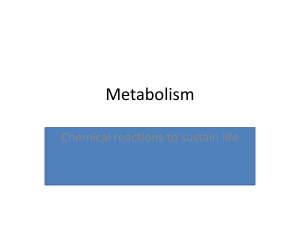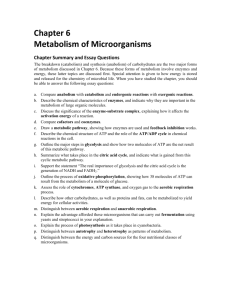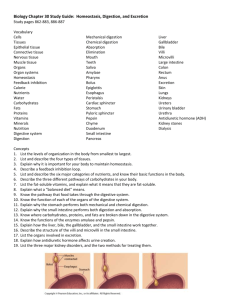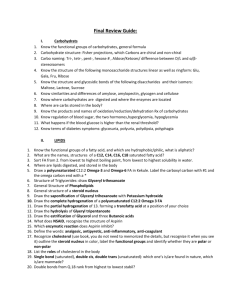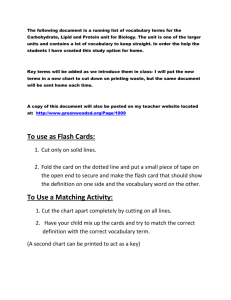Digestion of Carbohydrates
advertisement
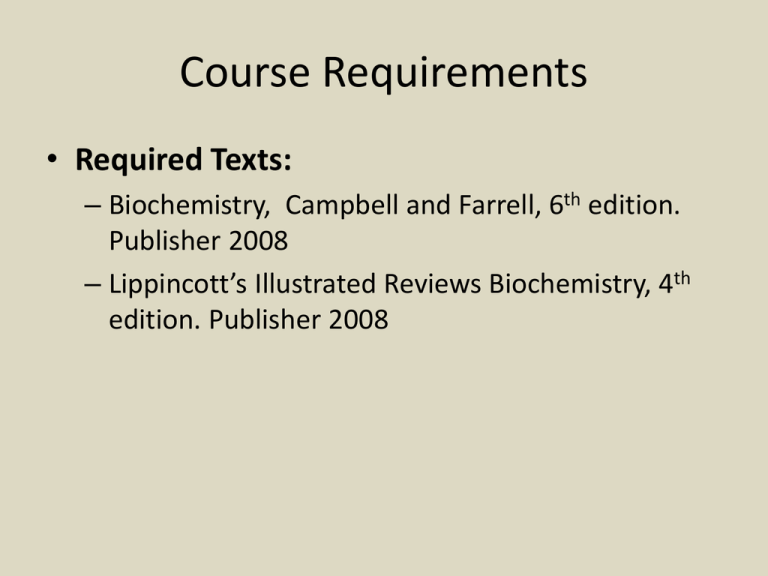
Course Requirements • Required Texts: – Biochemistry, Campbell and Farrell, 6th edition. Publisher 2008 – Lippincott’s Illustrated Reviews Biochemistry, 4th edition. Publisher 2008 The study of carbohydrates and lipids metabolism • I-Introduction: – Definition • metabolism of carbohydrates – – – – – – – Digestion of carbohydrates Glycolysis Tricarboxylic acid cycle Glycogen metabolism Gluconeogensis Pentose phosphate pathway and NADPH Metabolism of monosaccharides and disaccharides Lipids metabolism – Digestion of dietary lipids • • • • How fats are digested in animals How fats are mobilized and transported in tissues How fats are oxidized How “ketone bodies” are produced – Fatty acid and triacylglycerol metabolism – Biosynthesis of Complex lipid metabolism – Biosynthesis Cholesterol and steroidhormones Bioc 211 General metabolism http://www.runningforfitness.org/book/chapter-7-eating-drinking-andrunning/energy-while-running How the body converts food to energy? • We are going to look at two major questions in biochemistry – How do cells extract energy from their environment? – How do cells synthesis the building blocks of their macromolecules? • This leads to the study of .......... Introduction to Metabolism Campbell’ Chapter 15, P417 The nature of Metabolism • Metabolism: the chemical reactions of biomolecules, the sum total of all biochemical reactions that take place in an organism . It is the biochemical basis of life processes • Characters – Catalyzed by a specific enzyme • Each reaction require a specific enzyme – Typically occur in pathways ( in a sequence) • Several reactions in a row – Two major groups • Catabolism: the breakdown of complex substances Usually energyyielding!. • Anabolism: the synthesis of complex substances needed by cells from simpler ones such as DNA Usually energy-requiring!. Major purpose • living things require energy for: 2- Synthesis of biomolecules and simple precursors 3- Active transport of molecules and ions 1- Mechanical work in muscle contraction and other cellular movement What carries this energy?????? • The energy currency or coin of the cell is • Energy rich molecules triphosphate contains 2 phosphoanhydride bonds The 2 phosphate bonds (phosphoanhydride bond) is here the energy is stored in ATP The energy • A large amount of energy is liberated when – ATP → ADP + Pi (orthophosphate) – ATP → AMP + PPi (pyrophosphate) • The free energy liberated with the hydrolysis of ATP is used to drive reactions that require input of free energy The energy • ATP is continuously formed and consumed • It’s the principal immediate donor and not long term storage of energy • Rate of turnover of ATP is high. A molecule of ATP is consumed within a minute it is formed • Resting person consumes 40 kg of ATP / 24hr How do cells make ATP? • By phosphorylation... adding a phosphate to ADP ADP + P - - - - - -> ATP • 3 mechanisms of phosphorylation: – Substrate level phosphorylation ( where a substrate molecule (X-P) donates its high energy P to ADP making ATP) – Oxidative phosphorylation (e- transferred from organic molecules and passed through a series of acceptors to O2) – Photophosphorylation ( occurs during photosynthesislight energy used to make ATP) Electron carriers • When food molecule oxidized – electrons are removes • These electrons are carried to oxygen e- How does the e- get to oxygen?????? O2 Answers: electron carriers • NAD+/ FAD • Reduced form with electrons bound is NADH/ FADH2 • NADH/ FADH2 transfer e- to O2 in the mitochondria by means of ETC ( ATP generated in this process) The nature of Metabolism • Complex substances are broken down for energy, required metabolites, structural components, etc. • Cells must synthesize new complex substances. • Thousands of such reactions are occurring simultaneously in a single cell. The nature of Metabolism (cont’d) • These rxns occur with a minimum of side products, energy loss or undesired interferences and at reasonable temperatures, pH and pressure. • All of these rxns must be controlled or regulated for optimum efficiency. Free Energy Changes in Metabolism • Overall G is negative (-) for catabolic processes • For an anabolic process, the G ought to be positive (+) • So generally catabolic processes generate energy for anabolic processes General Principles: • Metabolic pathways are irreversible (because they must be regulated) • Metabolic pathways have (first) committed step • Metabolic pathways are regulated • Metabolic pathways are compartmentalized Principles (cont’d): • Metabolic reactions are often reversible • Processes of metabolism are highly controlled: – Anabolism and catabolism are not usually balanced - one or the other may predominate in certain cells or at different times depending on cell needs – The pathway to synthesize a complex substance is not simply the reverse of the degradative pathway. Principles (cont’d): • Metabolic pathways are compartmentalized • Cytosol (glycolysis, fatty acid biosynthesis, pentose phosphate cycle) • Mitochondria (TCA cycle, OxPhos, fatty acid oxidation, amino acid breakdown) • Nucleus (DNA replication, transcription, RNA processing) • ER – Rough ER: synthesis of membrane and secretory proteins – smooth ER: lipid and steroid biosynthesis • Golgi (posttranslational processing of proteins) Catabolism • catabolism: the breakdown of larger molecules into smaller ones; an oxidative process that releases energy – Breakdown of monomers to common intermediates, and thus to CO2 and electrons is accomplished through a central oxidative pathway: • The Citric Acid Cycle or TCA or the Krebs Cycle. • This cycle leads to the production of ATP by processes called electron transport and oxidative phosphorylation. Catabolism Proteins Amino acids polysaccharides Glucose/other sugars lipids Glycerol/fatty acids Pyruvate NH4+ Acetyl CoA Citric acid cycle →ETS/OxPhos →ATP Co2 Oxidative processes produce ATP & NADH for energy Anabolism • Anabolism: the synthesis of larger molecules from smaller ones; a reductive process that requires energy – utilization of critical Common intermediates including components of TCA cycle to make building blocks • Making building block requires energy = ATP • Synthesis of macromolecules requires energy = ATP • note CO2 not generally reused Proteins Amino acids Polysaccharides Glucose/other sugars Lipids Glycerol/fatty acids Pyruvate NH4+ Acetyl CoA Citric acid cycle Co2 Anabolism Intermediates Summary • In catabolism, large molecules are broken down to smaller products, releasing energy and transferring electrons to acceptor molecules of various sorts. The overall process is one of oxidation. • In anabolism, small molecules react to give rise to larger ones; this process requires energy and involves acceptance of electrons from a variety of donors. The overall process is one of reduction A Comparison of Catabolism and Anabolism • Metabolism is the sum total of the chemical reactions of biomolecules in an organism Anabolic vs catabolic reactions Anabolism Synthesis reactions Catabolism Degradation reactions General description Building of a large molecule (polymer) from smaller building blocks (monomer): A + B → A--B Breakdown of polymer into individual monomers: C—D → C + D Descriptive terms Building, constructive, anabolic Breakdown, digestive, decomposition, catabolic Bond formed broken Energy Energy is required (= Endergonic) Energy is released (= Exergonic) Water Water is released (= Dehydration) Water is required (= Hydrolysis) Example Building a protein from individual amino acids; Building a triglyceride from glycerol and 3 fatty acids, etc Breaking a protein into individual amino acids; Breaking starch down into monosaccharides, etc. General Pathways of Metabolism Breakdown of macromolecules to building blocks generally hydrolytic Large units of the cell M e t a b o li s m I polysaccharides Building blocks of the cell Glucose, other sugars Lipid membranes Fatty Acids/ Glycerol proteins Amino Acids Nucleic acids Nucleotides M e t a b o li s m II Metabolism Energy-containing nutrients are processed in three major stages: 1. Digestion – breakdown of food; nutrients are transported to tissues 2. Anabolism and formation of catabolic intermediates where nutrients are: - Built into lipids, proteins, and glycogen or - Broken down by catabolic pathways to pyruvic acid and acetyl CoA. 3. Oxidative breakdown – nutrients are catabolized to carbon dioxide, water, and ATP Summarize • Define metabolism • Distinguish between anabolism and catabolism Digestion of carbohydrates Lippincott’s chapter 7, P86 The digestive system Prepares food for use by all body cells The digestive process involves a series of physical and chemical actions that break down the components of food into nutrient particles small enough for absorption Digestion of Carbohydrates • The principle site of carbohydrates digestion are the mouth and small intestine • The dietary carbohydrate consist of: – Polysaccharides: starch glycogen and cellulose – Disaccharides: maltose, sucrose and lactose – Monosaccharides: mainly glucose and fructose • No need for monosaccharides digestion prior to absorption, whereas di/polysaccharides must be hydrolysed to simple sugars before their absorption Digestion of Carbohydrates • In the mouth - Chewing increases surface area of food allowing salivary αamylase to begin digestion of starch: • Some of the free glucose in food can be absorbed through lining of the mouth Digestion of Carbohydrates • In the stomach – – Carbohydrates digestion halts temporarily in the stomach – Salivary amylase is inactivated by stomach high acidity. Digestion of Carbohydrates • In the small intestine - the stomach contents are neutralised by pancreatic juice. – Pancreatic amylase continues digestion of starch to oligosaccharides and maltose. – Intestinal brush border membrane enzymes • Maltase hydrolyses maltose to glucose. • Sucrase hydrolyses sucrose to glucose + fructose • Lactase hydrolyses lactose to glucose + galactose – The end product of carbohydrates digestion are glucose which are readily absorbed through the intestinal mucosal cells into the blood stream Digestion of Carbohydrates • In the Large intestine – Humans do not produce and secrete β-(1-4) endoglucosidase in digestive juice • Humans unable to digest cellulose • undigested fibre is attacked by bacteria (generates bowel gas). • Fibre aids intestinal motility and acts as a softer • Fibre is eventually excreted Absorption of monosaccharides by intestinal mucosal cells • Different sugars have different mechanisms of absorption: – Glucose & galactose actively taken up by mucosal cells energy dependent secondary active transport (by Na+ pump). – Fructose is taken up by facilitative transport down concentration gradient via passive carrier mediated transport. • Adsorbed sugars diffuse from intestinal mucosal cell into portal circulation and are transported to the liver. Absorption of monosaccharides by intestinal mucosal cells Abnormal degradation of disaccharides • • • • • Hereditary deficiency Mal nutrition Drug injure the mucosa of the small intestine Lactose Intolerance - reduction in amount of lactase produced (common in Asians & Africans). Lactose is not hydrolysed but enters the large intestine and draws water in by osmosis which causes diarrhoea. Lactose is metabolised by bacteria generating CO2 and H2. Milk products need to be avoided. Sucrose Intolerance - reduction in amount of sucrase produced. Symptoms similar to lactose intolerance (found in 10% of Greenland Eskimos). Metabolic fate of carbohydrates • After being absorbed from the intestinal tract the monosaccharides are carried by the portal circulation to the liver – In the liver D-glucose phosphorylated to G-6-P – D-fructose and D-galactose are phosphorylated to and convert to glucose in the liver – G-6-P is an intermediate in several metabolic pathway that use glucose in the liver – Depending on the supply and demand includes • • • • • Glycolysis Glycogenesis Glycogenlysis Gluconeogenesis Pentose phosphate pathway Metabolic fate of carbohydrates Carbohydrate Metabolism Overview Glycogen Glycogenesis Pentose Glycogenlysis Glucose Gluconeogenesis PPP other sugars Glycolysis Pyruvate Lactate Acetyl CoA Citric acid cycle→ATP EtOH Summary • • • • • • • • Salivary α-amylase acts on dietary polysaccharides (glycogen, amylose, amylopectin), producing oligosaccharides. Pancreatic α-amylase continues the process of polysaccharide digestion. The final digestive processes occur at the mucosal lining of the small intestine. Several disaccharidases [for example, lactase (β-galactosidase), sucrase, maltase, and isomaltase] produce monosaccharides (glucose, galactose, and fructose). These enzymes are secreted by and remain associated with the luminal side of the brush border membranes of intestinal mucosal cells. Absorption of the monosaccharides requires specific transporters. If carbohydrate degradation is deficient (as a result of heredity, intestinal disease, malnutrition, or drugs that injure the mucosa of the small intestine), undigested carbohydrate will pass into the large intestine, where it can cause osmotic diarrhea. Bacterial fermentation of the compounds produces large volumes of CO2 and H2 gas, causing abdominal cramps, diarrhea, and flatulence. Lactose intolerance, caused by a lack of lactase, is by far the most common of these deficiencies. Summarize Q 1T/F • The enzyme α–amylase: 1. 2. 3. 4. 5. Hydrolyses glycogen to give glucose and maltose Is present in saliva Is activated by trypsin in the small intestine Hydrolyses cellulose to glucose and maltose If absent from pancreatic secretion, results in incomplete digestion of starch, a large bacterial population in the faeces and diarrhoea A 1 T/F • The enzyme α–amylase: 1. Hydrolyses glycogen to give glucose and maltose (T) 2. Is present in saliva (T) 3. Is activated by trypsin in the small intestine (F) 4. Hydrolyses cellulose to glucose and maltose (F) 5. If ibsent from pancreatic secretion, results in incomplete digestion of starch, a large bacterial population in the faeces and diarrhoea (T) Q2 T/F • The absorption of glucose in the digestive tract: 1. 2. 3. 4. Occurs in the small intestine Is an energy-requiring process Is stimulated by the hormone glucagon Occurs more rapidly than the absorbtion of any other sugar 5. Is impaired in cases of diabetes mellitus A 2 T/F • The absorption of glucose in the digestive tract: 1. 2. 3. 4. Occurs in the small intestine (T) Is an energy-requiring process (T) Is stimulated by the hormone glucagon (F) Occurs more rapidly than the absorbtion of any other sugar (F) 5. Is impaired in cases of diabetes mellitus (F) Q 3 T/F • Diasaccharides in the diet, or those formed from polysaccharide digestion: 1. Are absorbed as such by the small intestine 2. Are hydrolysed to constituent monosaccharides by enzymes present in pancreatic juice 3. Are hydrolysed by specific enzymes of the small intestine 4. Are quantitatively unimportant since there are no enzyme deficiency diseases associated with their metabolism A 3 T/F • Diasaccharides in the diet, or those formed from polysaccharide digestion: 1. Are absorbed as such by the small intestine (F) 2. Are hydrolysed to constituent monosaccharides by enzymes present in pancreatic juice (F) 3. Are hydrolysed by specific enzymes of the small intestine (T) 4. Are quantitatively unimportant since there are no enzyme deficiency diseases associated with their metabolism (F)
